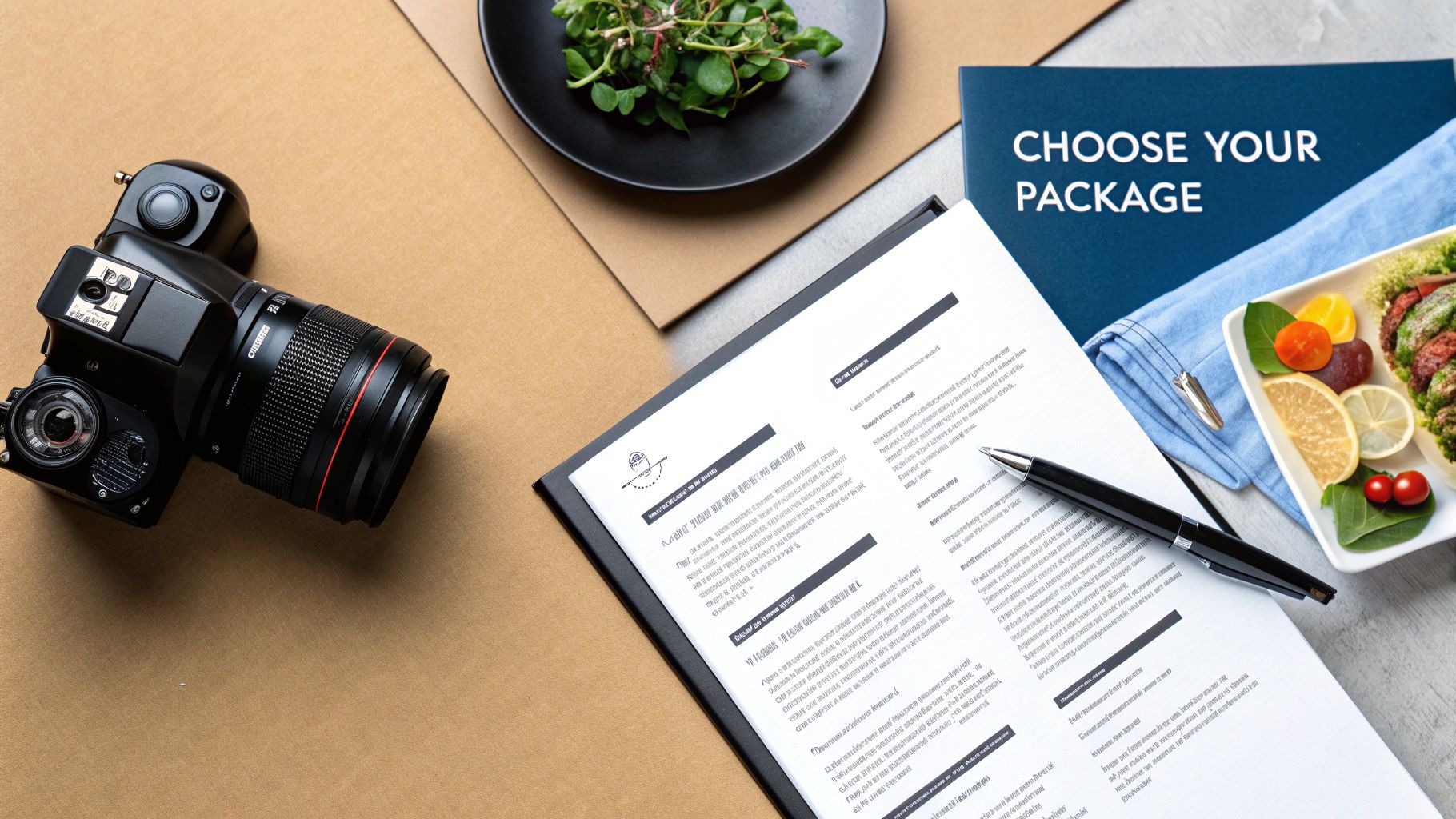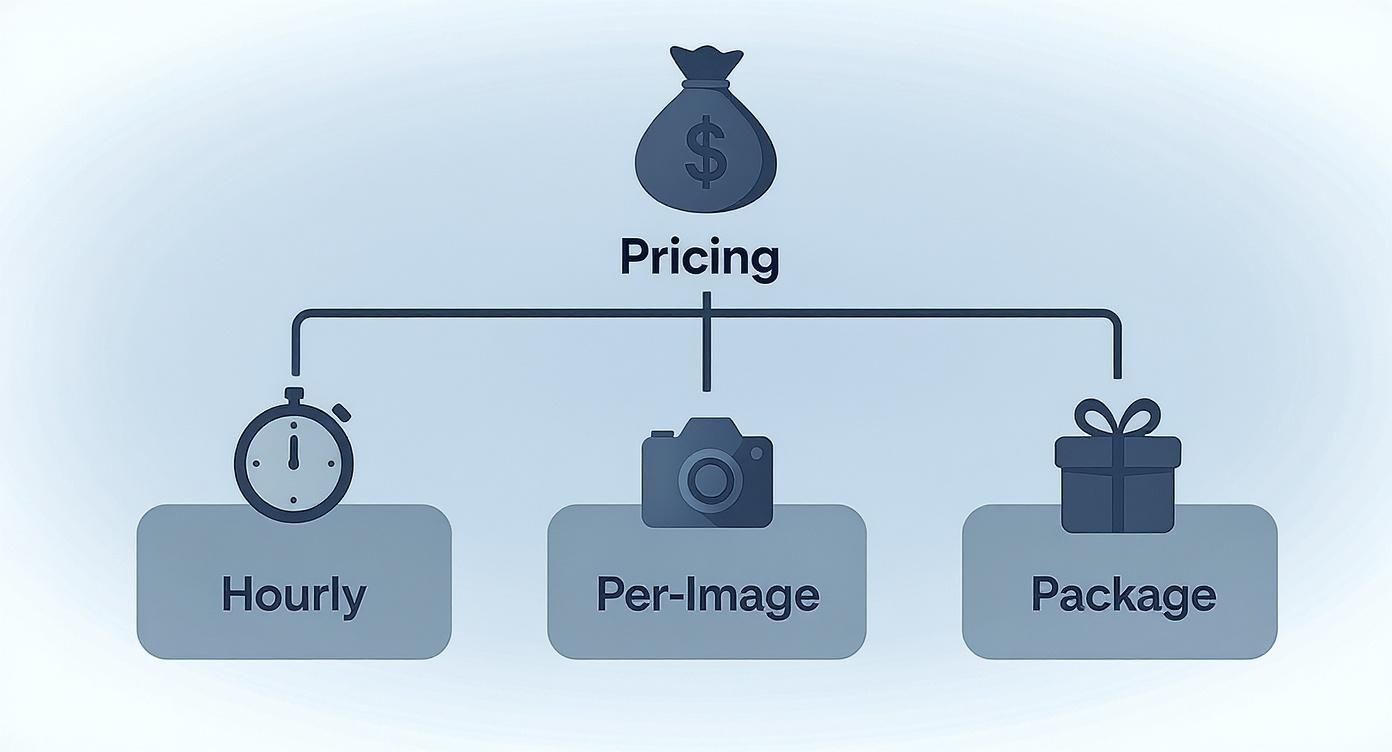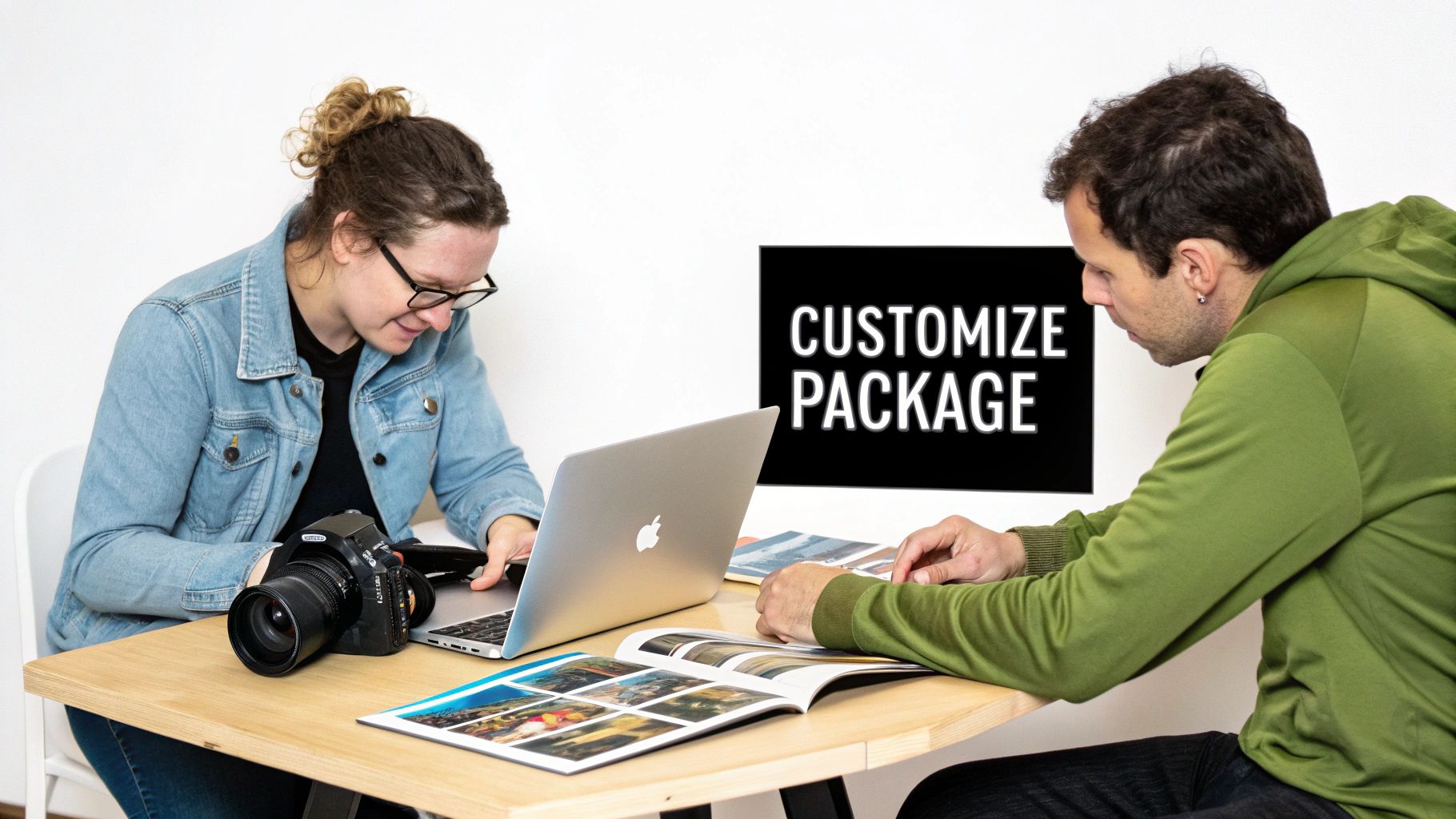When you see a photographer list their "packages," what does that even mean? Think of it as a bundled deal. Instead of picking every single service one by one (à la carte style), a package rolls everything into a single, fixed price. This usually includes a set amount of shooting time, a specific number of edited photos, and the rights to use them.
It’s designed to make your life easier. You get a clear picture of what you’re getting and what you’ll spend, often at a better value than if you’d paid for each piece separately.
Why Understanding Photography Packages Matters

Let's be honest, trying to make sense of a photographer's pricing list can feel like you’re trying to crack a code. This guide is here to be your key. A photography package isn't just a price tag; it's a complete blueprint for how your moments will be captured.
The best analogy is a restaurant menu. You could order every dish individually, or you could go for the set meal that gives you a full, satisfying experience for a better price. Photography packages work the exact same way—they bundle the essentials to deliver a complete service.
What's Inside a Typical Photography Package
So, what are you actually paying for? When you book a photography package, you’re investing in far more than a handful of digital files. You're securing a professional's expertise, time, and creative energy. Let's peel back the layers.
| Component | What It Covers | Why It Matters to You |
|---|---|---|
| Photographer's Expertise | Years of experience, a unique artistic eye, and the skill to handle any curveballs a shoot might throw. | This is the difference between a snapshot and a stunning portrait. You're paying for their ability to see and create, not just click a button. |
| Time Investment | This goes beyond the hours on-site. It includes consultations, planning, travel, and the extensive post-production work of sorting and editing images. | A two-hour shoot often means many more hours of behind-the-scenes work to get your photos just right. |
| Final Deliverables | The specific number of high-resolution, professionally edited images you'll receive. | This sets a clear expectation of the final product, ensuring there are no surprises about how many photos you'll get. |
| Usage Rights | The license that gives you permission to print and share your photos for personal use. | This is crucial! It defines how you can legally use the images your photographer creates for you. |
Looking at it this way helps shift your perspective from just cost to the actual value you're receiving. To really get a handle on this, it's also helpful to understand the nuances of different photography services, like the essential aspects of professional product photography.
A well-structured package provides clarity and confidence. It aligns expectations from the start, ensuring both the client and photographer are on the same page about the final outcome and total investment.
This kind of clear communication is the bedrock of a great photoshoot. A solid client onboarding process template can make this even smoother, setting the stage for a fantastic working relationship from day one.
Of course, the broader economy has a say, too. The photography market is constantly shifting, and with inflation, around 25% of photographers reported raising their prices by 6-10% in 2024. Packages have to balance these rising operational costs—things like gear, software, and insurance—while still staying competitive.
Once you understand these fundamentals, you can choose a package with confidence, knowing you’re not just buying photos, but investing in true skill and artistry.
Understanding Different Pricing Models
When you start digging into photography price packages, you’ll see pretty quickly that no two photographers price their work exactly the same way. It's a bit like hiring someone for a home project. You might pay a handyman by the hour for a quick fix, but you'd want a fixed project cost for a full kitchen remodel. Photographers work in a similar way.
Getting a handle on these models is the first step toward finding a package that fits what you need without any nasty budget surprises down the road. Each approach has its own pros and cons, making them better suited for different kinds of shoots. Let's break down the three most common structures you'll run into.
The Main Pricing Structures
The way a photographer charges for their work says a lot about the service they’re providing. A quick session for corporate headshots has totally different demands than an all-day wedding, and you can bet the pricing will reflect that. Most pros build their prices around one of these core methods.
-
Hourly Rate: This is as straightforward as it gets. You pay for the photographer's time, usually billed in one-hour chunks. It’s perfect for shorter, well-defined sessions like family portraits, professional headshots, or small events where the time commitment is easy to predict. An event photographer might charge between $100-$300 per hour, while a specialized wedding photographer's rate could be much higher.
-
Per-Image Pricing (À La Carte): With this model, you pay for each individual photo you decide to keep. You’ll often see this in commercial, product, or real estate photography, where a client just needs a specific number of killer images for a campaign or a listing. You might pay a session fee upfront, then buy your favorite digital files or prints after the fact.
-
Flat-Fee Packages: This is the go-to model for big events like weddings or extensive brand photoshoots. The photographer bundles everything—their time, a set number of edited images, and maybe even physical products like an album—into one fixed price. This gives you cost certainty from the start, which is a huge relief when you're managing a larger budget.
If you're trying to figure out what a fair rate even looks like, it helps to see what other creative freelancers are charging. Playing around with a freelance rate calculator can give you a much better feel for industry standards.
The real goal of any pricing model is to make the agreement totally transparent. Whether it’s by the hour or a big package deal, you should know exactly what you’re paying for and what you’re getting in return.
At the end of the day, the best model is the one that fits your specific project. Knowing the difference empowers you to compare photographers more effectively and pick someone whose structure aligns perfectly with your vision and budget. As you weigh your options, checking out a solid guide to pricing services can also help you grasp the core principles behind it all.
How Photographers Structure Their Packages
You've probably seen it a thousand times: the classic "Bronze, Silver, Gold" package lineup. It’s not just a random choice; it’s a seriously smart way for photographers to lay out their services so you can actually understand them.
Think of it like getting your car washed. You can go for the basic exterior clean, upgrade to get the interior vacuumed, or spring for the full-detail package that leaves it looking brand new. Each option is clear, and you pick the one that fits what you need and what you're willing to spend.
This tiered system gives you a simple way to compare value. Instead of getting hit with a huge, confusing menu of à la carte services, you get a handful of clear choices. Each one builds on the last, offering a more complete experience.
The infographic below breaks down the pricing models that often get bundled into these tiers.

As you can see, photographers can charge by the hour or per image, but bundling everything into a cohesive package is by far the most common approach. It just makes things easier for everyone.
What To Expect In Each Tier
Once you get the hang of what's typically inside each tier, you can quickly spot the right fit for your event. While a photographer might call their packages something totally different, the core idea is almost always the same.
-
Bronze (The Essential Tier): This is your entry point. It’s designed for smaller budgets or simpler needs, covering the absolute essentials. Think shorter coverage time and a smaller number of digital photos. It's a perfect match for a quick elopement or a short-and-sweet portrait session.
-
Silver (The Popular Tier): You'll often see this one labeled "most popular" for a reason. It hits that sweet spot right in the middle, balancing comprehensive coverage with a reasonable price. You’re usually looking at more hours, a bigger photo gallery, and maybe a nice little extra like a free engagement shoot.
-
Gold (The Premium Tier): This is the all-in, top-shelf experience. It’s for clients who don’t want to worry about a thing. Expect full-day coverage, a huge number of images, a second photographer to catch every angle, and premium goodies like a beautiful, high-quality photo album.
The tiered structure isn’t just about price—it's about matching the scope of the service to the client's vision. It empowers you to make a choice based on value, not just the bottom line.
This whole packaging strategy didn't come out of nowhere. The global photographic services market hit a staggering $37.37 billion in 2024 and is expected to climb to $43.77 billion by 2029. With social media, e-commerce, and a growing appreciation for quality photos driving demand, photographers have had to get flexible. You can dig deeper into the photographic services market to see how these trends are shaping what photographers offer.
Here’s a quick table to help you visualize how these tiers might look for something like a wedding.
Sample Tiered Package for Wedding Photography
A side-by-side look at typical inclusions across three pricing tiers to help you visualize the difference in value.
| Feature | Bronze Package (Essential) | Silver Package (Popular) | Gold Package (Premium) |
|---|---|---|---|
| Coverage Time | 6 Hours | 8 Hours | 10+ Hours (Full Day) |
| Photographers | 1 Primary Photographer | 1 Primary Photographer | 1 Primary + 1 Second |
| Digital Images | Approx. 300 edited images | Approx. 500 edited images | 700+ edited images |
| Photo Delivery | Online Gallery | Online Gallery + USB Drive | Online Gallery + Custom USB |
| Engagement Session | Not included (Add-on) | Included | Included |
| Print Products | $50 Print Credit | $150 Print Credit | 10×10 Custom Album |
| Typical Price | $2,500 | $4,000 | $6,000+ |
This breakdown makes it much easier to see where the extra investment goes. The jump from Bronze to Silver gets you more time and an engagement session, while the Gold package is a completely hands-off, all-inclusive experience with premium products.
Ever looked at two photographers' quotes and wondered why one is double the other for what seems like the same thing? The price tag on a photography price package isn't just a random number. It’s a carefully calculated reflection of a dozen hidden factors that all add up to the quality and value you get in the end.
Figuring out what you're really paying for is key. A photographer's rate is a mix of tangible costs and intangible skills. Think of it like a seasoned chef versus a line cook—both make food, but one has years of experience, a signature style, and the ability to turn a simple ingredient into a work of art. That's what you're investing in with a pro photographer.
The Photographer's Experience and Style
The single biggest factor is, without a doubt, the person behind the camera. An experienced pro has poured years into honing their craft, developing a signature look, and building a reputation for being reliable. That expertise means they can deliver incredible work every single time, handle any curveball—from bad lighting to a fussy toddler—and create art, not just snapshots.
Their unique style is a huge piece of the puzzle, too. A photographer known for a specific, in-demand aesthetic—whether that's light and airy, dark and moody, or bold and photojournalistic—can charge a premium. You're not just hiring someone to click a button; you're investing in their creative vision.
Location and Market Demand
Where your photographer is based matters. A lot. A pro working in a major city with a sky-high cost of living is going to have higher prices than someone in a small, rural town. It’s simple economics—the local market dictates what photographers need to charge to run a sustainable business.
And this isn't a small industry. The global photographic services market is massive, valued at around $35.78 billion in 2024 and it's only getting bigger. This growth shows that more people are recognizing the value of professional photography, which naturally supports more comprehensive (and more expensive) packages. You can see the full breakdown of the photographic services market growth on Precedence Research.
Behind-the-Scenes Business Costs
A huge chunk of any package price goes toward the less glamorous, but absolutely essential, costs of running a real business. These are the investments that make sure your experience is smooth, professional, and secure from beginning to end.
- Professional Equipment: We're talking high-end cameras, a collection of lenses, professional lighting, and—most importantly—backup gear. This stuff is incredibly expensive, often running into the tens of thousands of dollars.
- Software and Subscriptions: Editing tools like Adobe Lightroom, online gallery hosting services, and business management software all have monthly or annual fees that add up.
- Insurance and Legal Fees: Liability insurance is non-negotiable. It protects both the photographer and you, the client. Contracts and legal advice make sure everyone is on the same page.
- Post-Production Time: This is the hidden giant. For every hour spent shooting, a photographer easily spends two to three more hours culling, editing, and perfecting your images. This is where the real magic happens.
A higher price often signals a more stable and reliable business. It means the photographer is properly insured, uses professional-grade equipment, and invests in the tools needed to protect your memories and deliver a superior final product.
When you see a higher price, you're usually looking at someone who's more experienced, better equipped, and fully prepared to deliver results that will blow you away. For a deeper look at all the little things that add up, check out our full guide on how much a photography session costs.
How to Choose the Right Photography Package
Diving into the world of photography price packages can feel like a lot, but trust me, picking the right one is simpler than it looks. It really just boils down to one thing: figuring out what you actually need before you ever glance at a price tag.
When you stop focusing on just the cost, you can find a photographer whose style and service are the perfect fit for what you’re imagining.
Start by sketching out a quick roadmap for yourself. What does a "win" look like for you? Is it a couple of killer headshots for your new website? Or is it a full-day wedding documented from every possible angle? Getting that clarity is your best first move.
Define Your Non-Negotiables
Before you even think about looking at a pricing sheet, you have to get clear on your absolute must-haves. This goes way beyond the number of photos. It’s about the whole experience and getting a final product that actually does the job you need it to do.
So, grab a notebook and jot down the answers to a few key questions:
- What are these photos for? Are they a family heirloom in the making, content for your marketing, or a new batch of posts for social media?
- How much time do you really need? Think realistically. Is it a quick two-hour event, or are we talking about an eight-hour wedding day?
- What are the "can't-miss" shots? Get specific. Do you need certain family groupings, detailed product photos, or those perfect candid moments?
- What’s your real-deal maximum budget? Be honest here. It’ll save you a ton of heartache later.
Doing this little exercise forces you to get your priorities straight. For instance, a couple on a tighter budget might realize that six hours of solid coverage gets them all the key moments of their wedding, which suddenly opens up a whole range of more affordable packages.
Key Questions to Ask Every Photographer
Once you know what you need, you’re ready to start talking to people. Think of it like a casual interview. Any true pro will be happy to answer your questions—it shows you’re invested and know what you want. The whole point is to make sure there are zero surprises down the road.
Asking the right questions upfront is the best way to prevent misunderstandings later. It just makes sure you and the photographer are on the same page about what you’re getting, when you’re getting it, and what the whole process will feel like.
Use this as a checklist before you sign on the dotted line:
- Image Rights: What can I actually do with the photos? Am I free to print them wherever and share them online?
- Delivery Timeline: When will I get to see the final edited photos? What’s the turnaround for the full gallery?
- Editing Style: The photos in your portfolio—is that the style I can expect for my pictures? How much retouching do you typically do?
- Emergency Plans: Just in case—what’s your backup plan if you get sick or have an emergency on my shoot day?
- Payment Schedule: How much is the deposit, and when do I owe the final balance?
Getting these answers helps you compare packages based on what they truly offer, not just the sticker price. With this info in hand, you can confidently pick a photographer and a package that will bring your vision to life.
Customizing Your Package with Add-Ons
Think of a photographer's standard packages as a great starting point, not the final word. Most pros I know see their packages as a flexible foundation, ready to be tweaked and tailored to what you actually need. This is where the magic of à la carte add-ons comes in.
This whole approach is about building a photography experience that fits you perfectly. You only invest in the services and products you truly value, which means you're not paying for extras that just aren't you. It’s all about creating a bespoke plan that delivers exactly what you're dreaming of.

Popular Add-Ons to Consider
While every photographer has their own unique offerings, a few popular extras pop up time and time again. These are the add-ons that can really elevate your final collection of memories from good to unforgettable.
Here are some of the most common ones you'll see:
- Additional Coverage Hours: Worried your event might run a little long? Adding an extra hour or two of coverage is clutch for making sure no key moments get missed.
- Second Photographer: For big, sprawling events like weddings, a second shooter is invaluable. Seriously. They catch different angles, candid moments the main photographer might miss, and give you a much richer, more complete story of your day.
- High-Quality Prints & Canvases: Moving your images from a screen to your wall truly brings them to life. Professional-grade prints have a longevity and color accuracy you just can't get from your local one-hour photo lab.
- Custom-Designed Photo Albums: A professionally designed album is a timeless heirloom. It's a curated, tangible storybook of your event that you'll be flipping through for generations.
- Engagement or Portrait Session: Often bundled as a deal, this is a fantastic way to get comfortable in front of the camera before the main event. Think of it as a warm-up!
The best photography packages are born from a real conversation. Don't ever hesitate to tell your photographer exactly what you envision and what your budget looks like. They can often suggest creative solutions you hadn't even thought of.
This collaborative approach ensures your package is perfectly aligned with what you want. It's the same principle you'd use for any creative project; if you're also thinking about video, for instance, our guide on hiring a videographer offers some similar insights. The goal is always to create a plan that brings your vision to life without any unnecessary spending.
A Few Common Questions About Photography Packages
Let's dive into some of the questions that always seem to come up when clients are looking at photography packages. Getting these cleared up from the get-go will help you feel way more confident when you start chatting with photographers.
Do I Get the Copyright to My Photos?
This is a big one, and the short answer is almost always no. The photographer who created the images retains the legal copyright. It’s their artwork, after all.
What you get is a personal use license or a print release. Think of it as your official permission slip to print the photos for your home, share them with friends and family on social media, and enjoy them for all personal purposes. Using them for your business, however, is a whole different ballgame and requires a commercial license, which usually comes with a separate fee.
Why Is There a Limit on the Number of Photos?
You might wonder why you don't get every single photo the photographer took. Well, a photographer might snap hundreds, or even thousands, of pictures during a session to make sure they catch the perfect moments. The number you see in your package is the final, curated collection of the absolute best shots.
This isn't about holding back photos; it's about delivering quality over quantity. This process saves you the headache of sorting through hundreds of near-duplicates, blurry images, or shots where someone blinked. Each photo you receive has been hand-picked and professionally polished.
Can I Negotiate the Price of a Package?
This really depends on the photographer's business policies. Many have firm pricing to be fair to every client they work with. That said, some photographers might have a bit of wiggle room, especially if you’re booking during a slower season or putting together a large, custom package.
It never hurts to have a polite and honest conversation about your budget. Getting a handle on how to work with freelancers can give you some great pointers for navigating these kinds of professional chats. You might be surprised at what's possible.

